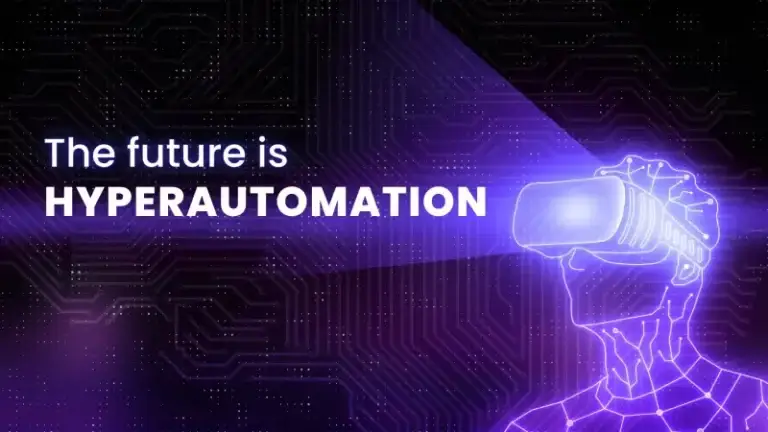The future is hyperautomation – Why automation is no longer enough


Larissa Varela
Pia, Global Director of Marketing
In 2020, Gartner identified hyperautomation as one of the Top 10 Strategic Technology Trends. Since then, many businesses, including Managed Service Providers, have started exploring its implementation. Yet, there is still a degree of misunderstanding when it comes to hyperautomation: what is it, how is it different from automation, and why is it the best choice for automating operations? This blog aims to resolve all of these queries.
What is automation?
Nowadays, automation is all around us, with the term becoming quite popular with the introduction of technologies such as GTPChat. But what is automation?
Automation refers to using technology to execute everyday, repetitive jobs usually done by humans, including data input, document handling, and report generation. Automation typically involves using tools like robotic process automation (RPA), which can perform these tasks automatically without human intervention through programs such as macros, scripts, and workflow software.
Automation’s primary goal is to enhance and speed up business operations and reduce errors by removing the need for manual intervention in these tasks.
What is Hyperautomation?
According to Gartner’s definition, “hyperautomation deals with the application of advanced technologies, including artificial intelligence (AI) and machine learning (ML), to increasingly automate processes and augment humans. Hyperautomation extends across a range of tools that can be automated, but also refers to the sophistication of the automation (i.e., discover, analyze, design, automate, measure, monitor, reassess.).”
In simpler terms, hyperautomation is a more advanced form of automation that involves the use of multiple technologies, such as artificial intelligence (AI), machine learning (ML), natural language processing (NLP), robotic process automation (RPA), virtual assistants, and low-code application platforms to automate complex tasks and business processes.
Hyperautomation combines automation with intelligence and decision-making capabilities, allowing for more flexible and adaptable automation solutions. It can automate tasks previously considered too complex or non-routine for automation, such as analyzing data and making informed decisions based on that data.
Why is automation no longer enough?
While automation only helps businesses execute repetitive, predefined tasks, hyperautomation takes automation to the next level by propelling smart, flexible strategies that point out the next steps to take instead of adhering to a predefined sequence.
Hyperautomation has the potential to transform entire business processes by enabling organizations to make more informed decisions, identify patterns and insights, and automate more complex tasks.
Why is hyperautomation key for any business?
Hyperautomation provides several benefits that can help organizations stay competitive and drive growth:
Increased efficiency: Hyperautomation can automate repetitive and manual tasks, freeing time for employees to focus on higher-level tasks requiring human skills and expertise. This can improve productivity and overall efficiency, enabling organizations to do more with fewer resources.
Improved accuracy: Automation can reduce errors and improve accuracy by eliminating manual tasks that are prone to mistakes. Hyperautomation can also leverage AI and ML to analyze and optimize data, making identifying and correcting errors easier.
Enhanced customer experience: Hyperautomation can help organizations provide better customer experiences by automating customer interactions, providing personalized recommendations and solutions, and reducing response times.
Cost savings: Hyperautomation can reduce costs by automating tasks and processes, reducing errors and waste, and improving overall efficiency. This can help organizations improve their bottom line and reinvest savings into other business areas.
Increased agility: Hyperautomation can help organizations respond more quickly to changing market conditions by streamlining processes and workflows, enabling faster decision-making, and improving overall agility.
In conclusion, hyperautomation is key for the future of any organization as it provides a powerful tool for driving efficiency, reducing costs, improving accuracy, and enhancing the customer experience. By leveraging the latest technologies, organizations can automate complex tasks and processes, enabling them to stay competitive and drive growth in today’s rapidly changing business environment.
To find out how Pia aiDesk unparalleled hyperautomation capabilities can take your MSP to the next level, book a demo today.
More to explore

How MSPs Use Workflow Automation to Scale Smarter and Deliver Better Service
Workflow automation enables MSPs to standardize processes, reduce onboarding time, and improve accuracy across clients. Learn how automation unlocks efficiency, boosts client satisfaction, and helps

Generative AI vs. agentic AI: What MSPs need to know
Explore how agentic AI is reshaping MSP operations—acting as an autonomous teammate that makes real-time decisions, reduces manual effort, and scales service delivery intelligently.

Introducing Pia Integration with Nilear MTX Pods
Pia now integrates with Nilear’s MTX Pods, bringing AI-driven triage and automation to dispatch and workflow tools—helping MSPs streamline service delivery like never before.
